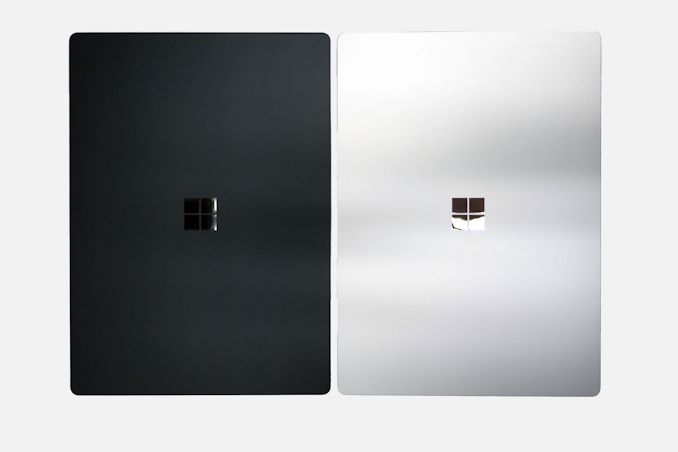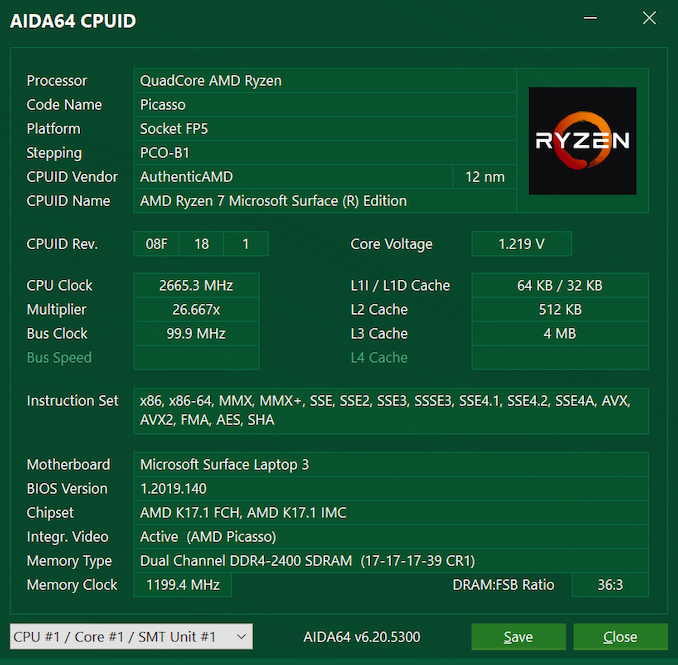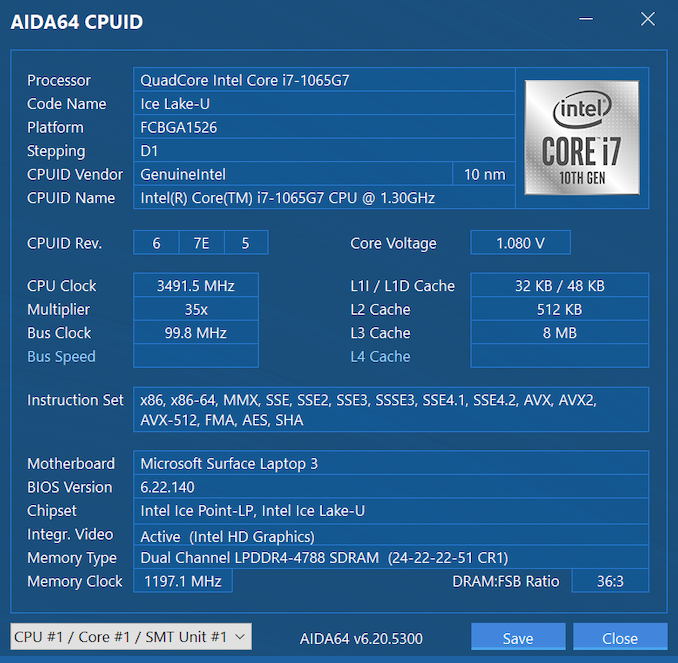The Microsoft Surface Laptop 3 Showdown: AMD's Ryzen Picasso vs. Intel's Ice Lake
by Brett Howse & Andrei Frumusanu on December 13, 2019 8:30 AM EST
Occasionally the stars align. It is very rare in the laptop space that we're able to test two devices, with two very different CPU platforms, with the fewest number of variables possible. But those stars have aligned in 2019, and thanks to Microsoft's Surface Laptop 3 family, we have a rare opportunity to compare AMD and Intel's current-generation laptop platforms in a way that wouldn't normally be possible.
In October at Microsoft’s Surface product launch in New York City, the Redmond company announced the new Surface Laptop 3 family, complete with a new 15-inch model. But what was particularly interesting for us is that the company launched not one, but two variants of this laptop: a consumer model based on AMD's Ryzen "Picasso" Zen+ APU platform, and a corporate model based on Intel's Ice Lake-U platform. And today we're going to get a chance to compare both of these laptops, pitting the top-end Ryzen 7 3780U model against the equally top-end Core i7-1065G7 model.
Microsoft sampled the Ryzen 5 3580U at the launch, and if you’ve not seen the Surface Laptop 3 review, be sure to check that out as well as it goes over the laptop in detail. Today’s focus will be strictly on what is inside.
| Microsoft Surface Laptop 3 Showdown | ||||||
| 15-Inch Consumer (AMD) |
15-Inch Enterprise (Intel) |
|||||
| Processor | AMD Ryzen 7 3780U 4C/8T, 2.3-4.0GHz, 15w |
Intel Core i7-1065G7 4C/8T, 1.3-3.9GHz, 8MB L3, 10nm |
||||
| Memory | 16 GB Dual-Channel DDR4-2400 | 16 GB Dual-Channel LPDDR4X-3733 | ||||
| Graphics | AMD Ryzen 7 3780U Vega 11 Graphics (11 CUs) |
Intel Core i7-1065G7 Intel Iris Plus "G7" Graphics (Gen 11, 64 EUs) |
||||
| Display | 15" 2496x1664 3:2 PixelSense Touch and Pen support Individually calibrated panels |
|||||
| Storage | 512 GB PCIe NVMe | 256 GB PCIe NVMe | ||||
| Networking | 802.11ac 2x2 MIMO Bluetooth 5.0 |
802.11ax Bluetooth 5.0 |
||||
| Audio | Omnisonic Speakers Dolby Audio Premium |
|||||
| Battery | 46 Wh 60 + 5 W AC Adapter |
|||||
| Right Side | Surface Connect Port | |||||
| Left Side | USB Type-A USB Type-C Headset Jack |
|||||
| Dimensions | 339.5 x 244 x 14.69 mm (13.4 x 9.6 x 0.57 inches) | |||||
| Weight | 1.54kg | |||||
| Camera | Front: 720p Camera and Windows Hello support Dual far-field Studio Mics |
|||||
| Extras | Surface Pen and Dial (sold separately) TPM 2.0 |
|||||
| Operating System | Windows 10 Home | Windows 10 Pro | ||||
| Pricing | 16GB/512GB/R7: $2099 | 16GB/256GB/i7: $1799 (16GB/512GB/i7: $2199) |
||||
As a quick refresher to the platforms we'll be testing, AMD launched the Picasso APU at CES in January 2019. Built on the GlobalFoundries' 12 nm process, it promised to be a significant upgrade to AMD's previous laptop / mobile platform, Raven Ridge. Featuring two or four cores based on AMD's Zen+ architecture, the processor peaks at 4.0 GHz in the top model. On the graphics side, AMD has continued with the Vega iGPU which has been so successful for them in the laptop space, providing significantly more 3D grunt than the previous Intel models could match.
Picasso ships with different size GPUs in terms of Compute Units (CUs) depending on the APU model. The lowest tier Ryzen 3 3200U offers just three CUs, the Ryzen 3 3300U offers six, the Ryzen 5 models offer eight, and the top-tier Ryzen 7 normally offers ten CUs. But for Microsoft and the Surface Laptop 3, AMD has quite literally taken that up to 11, with the Surface Laptop APUs coming with one additional compute unit, bringing about Vega 9 and Vega 11 respectively.
Picasso has been a solid offering, bringing a much-needed boost to AMD’s laptop focused efforts. Raven Ridge suffered from particularly high idle power draw and we were glad to see that AMD has addressed that to a degree with Picasso, although they still have work to do in that area. They also entered 2019 supporting only DDR4-2400, putting them at a disadvantage in the laptop space compared to the LPDDR that most laptops ship with, although Intel has been slow to move to LPDDR4, they’ve finally made that jump.
When it comes to Picasso and today's article, it should also be noted that like previous AMD APUs before it, AMD's fully integrated chips are about half a generation behind their discrete CPUs and GPUs. So while AMD is shipping the even newer Zen 2 architecture on desktops and servers, it's not yet available for laptops. Instead, the Zen+ based Picasso is still their current-generation platform for mobile.
On the Intel side, Microsoft opted for Intel’s Ice Lake platform for the business version of the Surface Laptop 3. Intel's latest and greatest platform, Ice Lake has seen a rough bring-up. Intel’s manufacturing woes are well documented, and it's only now, after more than two years of delays that Intel is shipping 10 nm chips in volume.
Intel’s Ice Lake platform features the new Sunny Cove CPU architecture, which Intel claims has an 18% higher Instruction-per-clock rate (IPC) than its outgoing Skylake microarchitecture, which has more or less played out to be pretty accurate. But the new 10 nm process is not as optimized as the outgoing 14 nm one has become, and the top-tier Ice Lake Core i7-1065G7 maxes out at just 3.9 GHz, a 20% lower clockspeed than Intel's top-tier 14 nm laptop chip, the 4.9 Ghz Comet Lake Core i7-10510U. So, while Intel’s newest CPU is still faster than the old one, things are never as clear as they may seem. With an 18% IPC increase but 20% lower peak clockspeeds, the overall net gain has not been very much. Luckily for Intel, they have enjoyed a significant historical CPU performance lead, which has buffered them somewhat in the laptop space.
But for everything going on with the CPU of Ice Lake, it's the GPU side where things really get interesting. Intel’s integrated GPU offerings have been sufficient for desktop use for quite some time – but just so. Intel has offered excellent media blocks, however the 3D gaming performance of their standard chips has been lacking, especially compared to AMD’s excellent Vega iGPU. Ice Lake addresses that in a couple of ways. The first is through their new Gen 11 graphics architecture, bringing about some minor architectural changes to improve their performance. The second is how much die space Intel is outright allocating for the GPU. In terms of the top-tier processor, the amount is a lot. The latest Intel Comet Lake Core i7-10510U processor offers 24 Execution Units (EUs) of Gen 9.5 graphics, but Intel’s Ice Lake processors offer up to 64 EUs of Gen 11 graphics.
Ice Lake also offers some new functionality, including the much-needed introduction of LPDDR4X support. LPDDR4X not only offers more memory bandwidth (up to 60.6GB/sec), but it's also available in higher capacities than the last-generation LPDDR3, finally allowing low power laptops to pack in more than 16GB of RAM. There’s also broader Thunderbolt 3 support, as well as major improvements to Modern Standby which provides a more tablet-like experience when resuming the device. It all adds up to a significantly better offering than Intel was able to achieve previously.
The Showdown
As stated earlier, it is rare to get a chance to test two different laptop platforms within the same laptop chassis. For various reasons, manufacturers typically use different chassis designs for different platforms – to accommodate things like differences in PCB sizes and batteries – making it difficult to do an apples-to-apples laptop platform comparison. Being able to review two platforms within the same laptop design is incredibly important, since as we’ve seen so many times, the manufacturer can play a significant role in overall system performance based on what the select for a laptop’s size, weight, cooling capabilities, and its SoC power limits.
Consequently, the Microsoft Surface Laptop 3 15-inch laptops are as close to an apples-to-apples comparison between Picasso and Ice Lake as you can make. They both feature the top-end processor from each manufacturer, both offer 16 GB of RAM, and both share the same chassis for cooling.
The remaining differences between the laptops are minor. The AMD laptop features a 512 GB SK-Hynix NVMe SSD, whereas the Intel one ships with a 256 GB Toshiba drive. The Intel laptop features an Intel Wi-Fi 6 wireless adapter, and the AMD model offers a Qualcomm Wi-Fi 5 model. And, the AMD laptop features the black anodized aluminum finish, and the Intel version is silver. None of which should impact our testing too significantly.












174 Comments
View All Comments
TheinsanegamerN - Friday, December 13, 2019 - link
It isnt just speed, the intel chip uses LPDDR4X. That's an entirely different beat from LPDDR4, let alone normal DDR4.AMD would need to redesign their memory controller, and they have just...not done it. The writing was on the wall, and I have no idea why AMD didnt put LPDDR4X compatibility in their chips, hell I dont know why intel waited so long. The sheer voltage difference makes a huge impact in the mobile space.
You are correct, pushing those speeds at normal DDR4 voltage levels would have tanked battery life.
ikjadoon - Friday, December 13, 2019 - link
Sigh, it is just speed. DDR4-2400 to DDR4-3200 is simply speed: there is no "entirely new controller" needed. The Zen+ desktop counterpart is rated between DDR4-2666 to 2933.LPDDR4X is almost identical to LPDDR4: "LPDDR4X is identical to LPDDR4 except additional power is saved by reducing the I/O voltage (Vddq) to 0.6 V from 1.1 V." Whoever confused you that LPDDR4X is "an entirely different beat" from LPDDR4 is talking out of their ass and I caution you to believe anything else they ever say.
And, no: DDR4-3200 vs DDR4-2400 would've tanked battery life, but simply made it somewhat worse. DDR4-3200 can still run on the stock 1.2V that SO-DIMM DDR4 relies on, but it's pricier and you'd still pay the MHz power penalty.
I don't think RAM speed/voltage has ever "tanked" a laptop's battery life: shaking my head here...
mczak - Friday, December 13, 2019 - link
I'm quite sure you're wrong here. The problem isn't the memory itself (as long as you get default 1.2V modules, which exist up to ddr4-3200 itself), but the cpu. Zen(+) cpus require higher SoC voltage for higher memory speeds (memory frequency is tied to the on-die interconnect frequency). And as far as I know, this makes quite a sizeable difference - not enough to really matter on the desktop, but enough to matter on mobile. (Although I thought Zen+ could use default SoC voltage up to ddr4-2666, but I could be wrong on that.)Byte - Friday, December 13, 2019 - link
Ryzen had huge problems with memory speed and even compatibility at launch. No doubt they had to play it safe on laptops. They should have it mostly sorted out with Zen 2 laptop, it is why the notebooks are a gen behind where as intel notebook are usually a gen ahead.ikjadoon - Saturday, December 14, 2019 - link
We both agree it would be bad for battery life and a clear AMD failure. But, the details...more errors:1. Zen+ is rated up to DDR4-2933. 3200 is a short jump. Even then, AMD couldn't even rate this custom SKU to 2666 (the bare minimum of Zen+). AMD put zero work into this custom SKU (whose only saving grace is graphics and even that was neutered). It's obviously a low-volume part (relative to what AMD sells otherwise) or such a high-profile design win.
2. If AMD can't rate (= bin) *any* of its mobile SoC batches to support even 2666MHz at normal voltages, I'd be shocked.
For any random Zen+ silicon, sure, it'd need more voltage. The whole impetus for my comments are that AMD created an entire SKU for Microsoft and seemed to take it out of oven half-baked.
Or, perhaps they had binned the GPU side too much that very few of those CU 11 units could've survived a second binning on the memory controller.
azazel1024 - Monday, December 16, 2019 - link
So all that being said, yes it had a huge impact. GPU based workloads are heavily memory speed dependent. Going from 2400 to 3200MHz likely would have seen a 10-25% increase in the various GPU benchmarks (on the lower end for those that are a bit more CPU biased). That changes AMD from being slightly better overall in GPU performance to a commanding lead.On the CPU side of things, many of the Intel wins were on workloads with a lot of memory performance needed. Going from 2400 to 3200 would probably have only resulted in the AMD chip moving up 3-5% in many workloads (20-40% in the more memory subsystem dependent SPEC INT tests), but that would have still evened the playing field a lot more.
Going to 3766 like the Intel chip would have just been even more of the same.
Zen 2 and much higher memory bandwidth can't come soon enough for AMD.
Zoolook - Saturday, December 21, 2019 - link
It's not about binning, they couldn't support that memory and keep within their desired TDP because they would have to run infinity fabric at a higher speed.They could have used faster memory and lower CPU and/or GPU speed but this is the compromise they settled on.
Dragonstongue - Friday, December 13, 2019 - link
AMD make/design for a client what that client wants, in this case, MSFT as "well known" for making sure to get (hopefully pay much for) what they want, for only reasons that they can understand.this case, AMD really cannot say "we are not doing that" as this would mean loss of likely into the millions (or more) vs just saying "not a problem, what would you like?"
MSFT is very well known for catering to INTC and NVDA whims (they have, still do, even if it cost everyone many things)
still they AMD and MSFT should have "made sure" to not hold back it's potential performance by using "min spec" memory speed, instead choosing the highest speed they know (through testing) it will support.
I imagine AMD (or others) could have chosen to use LP memory selection as I call BS on others saying AMD would have no choice but to rearchitecture their design to use the LP over standard power memory, seeing as the LP is likely very little changes need to be done (if any compared to ground up for an entirely different memory type)
they should have "upped" to the next speed levels however instead of 2400 baseline, 2666, 2933, 3000, 3200 as power draw difference is "negligible" with proper tuning (which MSFT likely would have made sure to do...but then again is MSFT whom pull stupid as heck all the time, so long it keeps their "buddies happy" who care about the consumers themselves)
mikeztm - Friday, December 13, 2019 - link
LPDDR4/LPDDR4X is not related to DDR4.It's a upgraded LPDDR3 which is also not related to DDR3.
LPDDR family is just like GDDR family and are total different type of DRAM standard.
They almost draw 0 watt when not in use. And in active ram access they do not draw less power significantly compare to DDR4.
LPDDR4 was first shipped with iPhone 6s in 2015 and it takes Intel 4 years to finally catch up.
BTW this article has a intentional typo: LPDDR4 3733 on Intel is actually quad channel because each channel is half width 32bit instead of DDR4 64bit.
Dragonstongue - Friday, December 13, 2019 - link
AMD make/design for a client what that client wants, in this case, MSFT as "well known" for making sure to get (hopefully pay much for) what they want, for only reasons that they can understand.this case, AMD really cannot say "we are not doing that" as this would mean loss of likely into the millions (or more) vs just saying "not a problem, what would you like?"
MSFT is very well known for catering to INTC and NVDA whims (they have, still do, even if it cost everyone many things)
still they AMD and MSFT should have "made sure" to not hold back it's potential performance by using "min spec" memory speed, instead choosing the highest speed they know (through testing) it will support.
I imagine AMD (or others) could have chosen to use LP memory selection as I call BS on others saying AMD would have no choice but to rearchitecture their design to use the LP over standard power memory, seeing as the LP is likely very little changes need to be done (if any compared to ground up for an entirely different memory type)
they should have "upped" to the next speed levels however instead of 2400 baseline, 2666, 2933, 3000, 3200 as power draw difference is "negligible" with proper tuning )
IMO